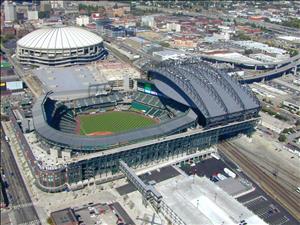(Pictured: T-Mobile Park (previously called Safeco Field) became the Seattle Mariners’ home 25 years ago. Also seen here is the Kingdome, where the team played until the domed edifice was torn down).
By Glenn Drosendahl
On July 15, 1999, Safeco Field — a long-sought (and since renamed T-Mobile Park) baseball-only stadium with a retractable roof — opened to critical acclaim and some public resentment.
The new half-billion dollar home of the Seattle Mariners is the product of a financing plan thrashed out by the Legislature after a different public-private financing plan was narrowly defeated at the polls. Construction was rushed and made more difficult by many design changes. But when the building opened, it was a showcase for the city and a moneymaker for the Mariners.
Team owners had complained about the Kingdome almost from the time the major league team began playing there in 1977. King County owned the massive concrete building, which had opened in 1976 with the National Football League’s Seattle Seahawks as its primary tenant. It was designed as a multi-purpose stadium, but was better-suited for football. And, as a series of Mariners owners pointed out, it lacked the revenue-producing features of newer baseball stadiums, putting them at a competitive disadvantage. The Mariners’ Kingdome lease was due to expire in 1996, and the team’s owners were not inclined to renew it. They wanted a new stadium and public money to help build it.
On Jan. 11, 1995, a task force appointed by then-King County Executive Gary Locke recommended the public pay about 65 percent of the cost of a new baseball-only stadium on county-owned land south of the Kingdome. The new stadium, estimated to cost between $243 million and $278 million, would have a retractable roof and be designed to maximize the team’s revenues. The task force said that without such a stadium, the Mariners had no future in Seattle.
Responding to the task force recommendation, the Legislature passed a financing plan that would raise the sales tax in King County from 8.2 percent to 8.3 percent. The county approved the plan in late July. It would require voter approval in September, however, and polls suggested it had little chance. The Mariners gained support by being in a pennant race for the first time in their history, but it wasn’t quite enough. The financing plan was defeated by less than 1 percent of the vote.
The Mariners owners, led by John Ellis, said they would sell the team if the ballot measure lost. But with fan interest mounting daily as the team contended for the playoffs, the owners said they would delay their decision until Oct. 31. By Oct. 2, the Mariners were division champions for the first time. On Oct. 8, they beat the New York Yankees in an epic playoff series and were off to play for the American League championship. Meanwhile, Ellis met with Governor Mike Lowry and legislative leaders to make the case for a new stadium. While the Mariners were playing the Cleveland Indians for the league title, Lowry called a special session of the Legislature to deal with the stadium issue.
After intense debate, the Legislature authorized a tax package to fund a $320 million stadium; the package was then approved by the King County Council. The taxes would be on food and drink sold at restaurants, bars, and taverns in King County, on car and truck rentals, and on tickets sold at the new stadium. This time, voter approval wasn’t required, a source of rancor among those who opposed the earlier financing plan.
The stadium was inspired by popular retro-style ballparks built earlier in the 1990s in Baltimore, Cleveland, and Denver. It combined nostalgic touches such as a red brick exterior and hand-operated scoreboard with modern touches such as restaurants, wide concourses, and a giant video screen in centerfield. When the gates opened in 1999, more than 40,000 fans saw the Seattle Symphony Orchestra play “Thus Sprach Zarathustra,” the theme from the movie “2001: Space Odyssey,” while the roof silently and majestically rolled opened. Play-by-play broadcaster Dave Niehaus, who had been with the team since its inception, donned a tux and threw out the ceremonial first pitch. After 22 years of playing their home games on artificial turf — and five years of fighting for a new stadium — the Mariners were treated to real grass and blue skies.
The ballpark quickly proved its value. Attendance for its first two seasons topped 6.6 million, the best in the major leagues. By the end of 2002, the Mariners had paid off their $100 million line of credit for cost overruns, and payment on the public debt was running ahead of schedule. Some of that payback was driven by the action on the field, but a good share could be attributed to the sheer attractiveness of the ballpark.
Source: Historylink.org, a non-profit online encyclopedia of Washington state history.
